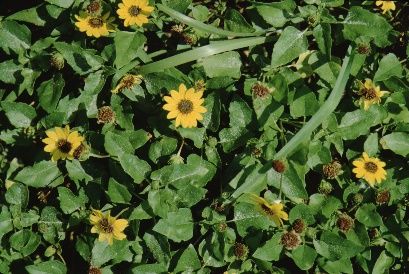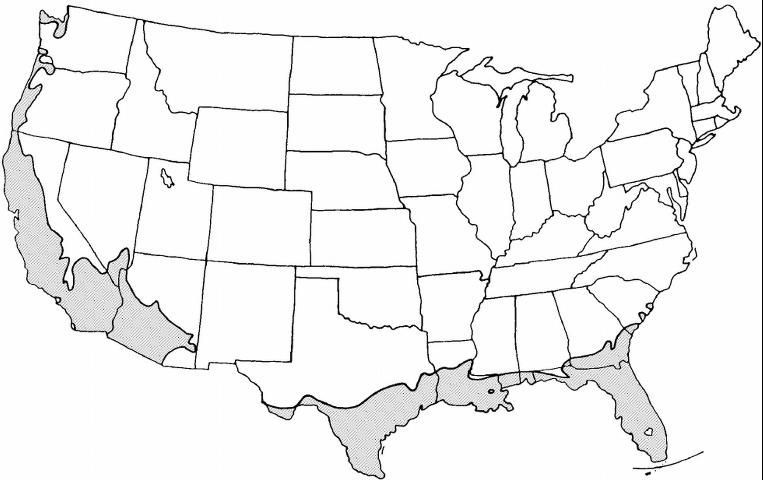Introduction
The beach sunflower is a spreading perennial that has attractive, small, sunflower-like flower heads, which are borne throughout the year. These showy flowers have 10 to 20 pale yellow rays that encircle a purplish-brown disk that is 0.5 to 1 inch wide. Different species of butterflies are attracted to these charming flowers. The 3-inch-wide flowers of this plant are followed by small seeds that readily germinate to produce plantlets. The beach sunflower has small, dark green, deltoid leaves that are irregularly lobed and toothed. These glossy leaves are roughly pubescent and attain a length of 4 inches.

Credit: Edward F. Gilman, UF/IFAS
General Information
Scientific name: Helianthus debilis
Pronunciation: heel-ee-ANTH-us DEB-bil-liss
Common name(s): beach sunflower, cucumberleaf sunflower, east coast dune sunflower
Family: Asteraceae
Plant type: herbaceous; perennial; ground cover
USDA hardiness zones: 8B through 10 (Figure 2)
Planting month for zone 8: May; Jun; Jul
Planting month for zone 9: Apr; May; Jun; Jul; Aug
Planting month for zone 10 and 11: Feb; Mar; Apr; May; Jun; Jul; Aug; Sep; Oct; Nov; Dec
Origin: native to Florida
Invasive potential: not known to be invasive
Uses: ground cover; attracts butterflies; border; mass planting; cascading down a wall; edging
Availability: somewhat available, may have to go out of the region to find the plant

Credit:
Description
Height: 2 to 4 feet
Spread: 2 to 4 feet
Plant habit: spreading
Plant density: dense
Growth rate: fast
Texture: medium
Foliage
Leaf arrangement: alternate
Leaf type: simple
Leaf margin: dentate
Leaf shape: deltoid
Leaf venation: pinnate
Leaf type and persistence: semi-evergreen
Leaf blade length: 2 to 4 inches
Leaf color: green
Fall color: not applicable
Fall characteristic: not applicable
Flower
Flower color: yellow
Flower characteristic: year-round flowering
Fruit
Fruit shape: unknown
Fruit length: unknown
Fruit cover: dry or hard
Fruit color: unknown
Fruit characteristic: attracts birds; inconspicuous and not showy
Trunk and Branches
Trunk/bark/branches: typically, multi-trunked or clumping stems
Current year stem/twig color: green
Current year stem/twig thickness: medium
Culture
Light requirement: plant grows in full sun
Soil tolerances: acidic; alkaline; sand; loam
Drought tolerance: high
Soil salt tolerances: good
Plant spacing: 18 to 24 inches
Other
Roots: not applicable
Winter interest: plant has winter interest due to unusual form, nice persistent fruits, showy winter trunk, or winter flowers
Outstanding plant: not particularly outstanding
Pest resistance: no serious pests are normally seen on the plant
Use and Management
Beach sunflower is often used as a flowering ground cover along and near the beach and reaches a height of about 18 inches. This plant spreads by underground runners and will quickly fill in an area if provided with occasional irrigation along the beach front. Over irrigation in other locations can slow growth and cause plant decline. One or two applications of fertilizer during the year will encourage plants to establish and cover the ground quickly. It looks great when massed as a ground cover. The cut flowers are charming in arrangements indoors.
The beach sunflower grows best on well-drained sandy soils. This plant will not tolerate over-watering or over fertilizing and is very drought tolerant. It needs to be placed in an area that receives full sun and will endure high levels of salt spray. Beach sunflower is an annual in those areas that have freezing temperatures in the winter; however, it will reseed itself or act as a perennial in central Florida.
Varieties and cultivars: var. cupreatus, copper-red rays; var. purpureus, pink or violet rays; var. roseus, rose colored rays; 'Dazzler', chestnut and orange head; 'Excelsior', yellow, red, brown, and purple head; 'Orion', deep yellow head.
Use seeds to propagate this lovely plant.
Pests and Diseases
No pests or diseases are of major concern.